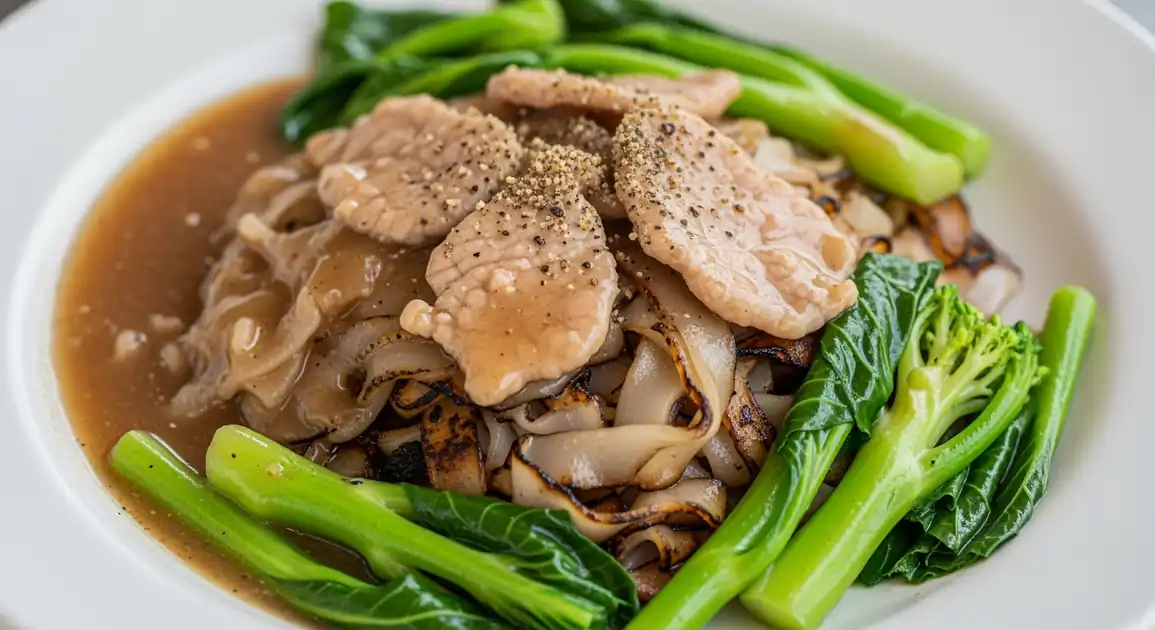Gravy Noodles (Rad Na)
ราดหน้า

Description
Rad Na is a ubiquitous dish found across Thailand, from bustling street stalls to local eateries and food courts. It's a beloved comfort food enjoyed as a quick lunch, dinner, or late-night meal. While variations exist, the core concept of noodles topped with savory gravy remains consistent.
Dietary Information
Serving information
Serving style
Served hot on a plate. Always accompanied by a caddy of four condiments: chili vinegar ('Prik Nam Som'), sugar, fish sauce ('Nam Pla'), and dried chili flakes ('Prik Bon'). Eaten with a fork and spoon.
Quick facts
Lunchtime (approx. 10 AM - 3 PM) and Evening (approx. 5 PM - 11 PM), varies greatly by vendor.
Safety Tips
What to Look For
-
Dish cooked fresh to order
Ensures noodles are properly stir-fried and the gravy is heated thoroughly, minimizing risks of bacterial growth in lukewarm food.
-
Served piping hot
High temperature indicates recent cooking and helps ensure food safety.
-
Vibrant, fresh-looking Chinese broccoli (Gai Lan)
Wilted, yellowing, or slimy greens indicate lack of freshness and poor quality.
-
Clean wok and cooking station
General cleanliness suggests better hygiene practices during preparation.
-
High customer turnover
A busy stall usually means ingredients are replenished frequently and food is cooked continuously.
-
Gravy is simmering or freshly prepared
Avoid gravy that looks like it's been sitting out at room temperature for extended periods.
What to avoid
-
Pre-fried noodles sitting in a pile
Noodles lose texture and may not be reheated adequately when the gravy is added.
-
Large batches of lukewarm gravy
Gravy held at improper temperatures can be a breeding ground for bacteria.
-
Wilted, old, or discolored vegetables
Indicates poor ingredient quality and potential spoilage.
-
Dirty condiment containers or utensils
Suggests poor overall hygiene standards which could lead to cross-contamination.
-
Visibly unclean vendor practices (e.g., handling money then food)
Increases the risk of transferring germs to the food.
Price information
Price range
Budget tips
- Street vendors and basic shophouse eateries offer the lowest prices (40-60 THB).
- Seafood versions ('Talay') are typically more expensive.
- Food court prices might be slightly higher than street stalls.
- Look for simple spots popular with locals for best value.
Value indicators
- Generous portion of meat/seafood and greens.
- Noticeable smoky 'wok hei' aroma/taste.
- Gravy is flavorful and has the right consistency (not too watery or starchy).
- Freshly prepared upon ordering.
Where to Find This Dish
Near Office Buildings / Markets
High concentration of vendors catering to lunch crowds and market shoppers.
Local markets ('Talad'), Business districts
Lunchtime (11 AM - 2 PM)
Evening Street Food Hubs
Areas known for evening street food often have dedicated Rad Na stalls.
Night markets, Popular street food streets
Evening (6 PM - 10 PM)
Shophouse Clusters
Look for simple Thai-Chinese eateries ('raan ahaan tam sang') that usually list Rad Na on their menu.
Local neighbourhood streets
Lunch, Dinner
Vendor Tips
- Look for vendors specializing primarily in Rad Na and Pad See Ew, suggesting expertise.
- Observe if they properly char the noodles in the wok for that essential smoky flavor.
- Check if they use fresh Chinese broccoli ('Gai Lan'/'Kana').
How to Order
Regional Variations
-
Rad Na Sen Yai
(ราดหน้าเส้นใหญ่)
The most classic version using wide, flat rice noodles.
-
Rad Na Sen Mee
(ราดหน้าเส้นหมี่)
Uses thin rice vermicelli noodles instead of wide ones.
-
Rad Na Mee Krob
(ราดหน้าหมี่กรอบ)
Features deep-fried crispy egg noodles ('Mee Krob') as the base, which soften slightly under the hot gravy.
-
Rad Na Moo
(ราดหน้าหมู)
Rad Na served with marinated pork slices.
-
Rad Na Gai
(ราดหน้าไก่)
Rad Na served with chicken pieces.
-
Rad Na Talay
(ราดหน้าทะเล)
Rad Na served with mixed seafood like shrimp, squid, and sometimes fish balls.
-
Rad Na Kai
(ราดหน้าใส่ไข่)
An egg ('Kai') is incorporated, either scrambled into the gravy or fried with the noodles.
Cultural context
History
Rad Na has its roots in Chinese cuisine, specifically Teochew cooking, brought to Thailand by immigrants. Over time, it was adapted to local Thai tastes, incorporating ingredients like fish sauce and Thai chilies (in condiments). It evolved into the distinct dish beloved today, commonly found alongside its 'dry' cousin, Pad See Ew, in many eateries.
Local significance
A staple comfort food in Thailand, appreciated for its savory flavor and satisfying texture. It represents the successful integration of Chinese culinary techniques into Thai cuisine.
Eating customs
- Use the provided spoon and fork (spoon in the right hand, fork in the left to push food onto the spoon).
- Taste the Rad Na first before adding condiments.
- Mix the gravy and noodles together before eating.